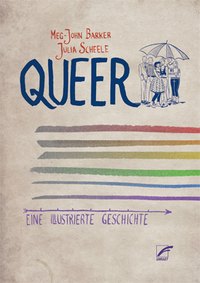Take a photo of a barcode or cover
1.06k reviews for:
Queer: Eine illustrierte Geschichte
Jennifer Sophia Theodor, Meg-John Barker, Julia Scheele
1.06k reviews for:
Queer: Eine illustrierte Geschichte
Jennifer Sophia Theodor, Meg-John Barker, Julia Scheele
This one was very academic, thorough, educational, historical, interrogative.
It is framed around the history of gender and queer theory development and the theorists behind major ideas. It was inclusive to LGBTQIAP2+ identities and made space for lesser seen identities like bi- and pansexuality, trans, non-binary and gender non comforming identities both in the western world and in international cultural identities such as the Hijra in India, the Dee/Tom culture of Thailand, and others. Intersectional identities of gender and sexuality as well as race, (dis)ability, class, religion, and age among others. All told through graphic novel format.
You'll learn key names like Foucault, hooks, Butler, and Spivak and theories within theories within theories. A bit dry in the middle, but always well-intentioned and with direct efforts to be inclusive and dispelling binaries of every sort. An encompassing crash course in queer theory though not accessible to all due to academic language.
It is framed around the history of gender and queer theory development and the theorists behind major ideas. It was inclusive to LGBTQIAP2+ identities and made space for lesser seen identities like bi- and pansexuality, trans, non-binary and gender non comforming identities both in the western world and in international cultural identities such as the Hijra in India, the Dee/Tom culture of Thailand, and others. Intersectional identities of gender and sexuality as well as race, (dis)ability, class, religion, and age among others. All told through graphic novel format.
You'll learn key names like Foucault, hooks, Butler, and Spivak and theories within theories within theories. A bit dry in the middle, but always well-intentioned and with direct efforts to be inclusive and dispelling binaries of every sort. An encompassing crash course in queer theory though not accessible to all due to academic language.
An enlightening and informative read, and more scholarly and theoretical than I was expecting. For me, this was a good thing. Only downside for me was the reliance on pop cultural persons as references/examples - these will date the text quickly and be lost on some readers within a few years.
challenging
informative
reflective
medium-paced
challenging
informative
slow-paced
informative
reflective
slow-paced
slow-paced
funny
hopeful
informative
inspiring
reflective
relaxing
medium-paced
Interesting overview but far too brief. Seems to take on too much, too briefly. Over all depth but no individual depth.
Plus i didn’t enjoy the dilution of lgbt identity
Plus i didn’t enjoy the dilution of lgbt identity
challenging
hopeful
informative
inspiring
reflective
medium-paced
informative
inspiring
reflective
Queer: A Graphic History is an easy-to-read introduction to the development and ideas of queer theory and how we can “queer” the world by disrupting norms and challenging binary ways of thinking (not just in terms of gender and sexuality, but also in the binaries of assimilationist/liberating, good/bad, etc). And so much more. I’ve had to take this book slowly some times I start it and other times I whip through it. It mentions the history while also pointing out a lot of the flaws of that history, and as someone who learned a lot of this material as I read the book (and who has no deeper knowledge to criticize from) really inspired me to want to learn and deconstruct more. (That sounds like a non-compliment lmao. The point is that it was a very motivating start for someone who wants to dig deeper).
For anyone who wants specifics, here are some of the things I found most intriguing and marked for deeper reading later:
1) bell hooks’s work about marginality as resistance to the “norm” instead of a place of despair, and the place of compassion in activism
2) Eve Kosofsky Sedgwick’s work calling attention to the fact that our definition of sexual orientation categorizes only by gender when there are SO MANY OTHER THINGS it could categorize by
3) Jack Halberstam’s “The Queer Art of Failure”
4) Sari van Anders’s sexual configurations theory, connected to #2 above
I loved this and will be recommending it to everyone ever lol
For anyone who wants specifics, here are some of the things I found most intriguing and marked for deeper reading later:
1) bell hooks’s work about marginality as resistance to the “norm” instead of a place of despair, and the place of compassion in activism
2) Eve Kosofsky Sedgwick’s work calling attention to the fact that our definition of sexual orientation categorizes only by gender when there are SO MANY OTHER THINGS it could categorize by
3) Jack Halberstam’s “The Queer Art of Failure”
4) Sari van Anders’s sexual configurations theory, connected to #2 above
I loved this and will be recommending it to everyone ever lol







